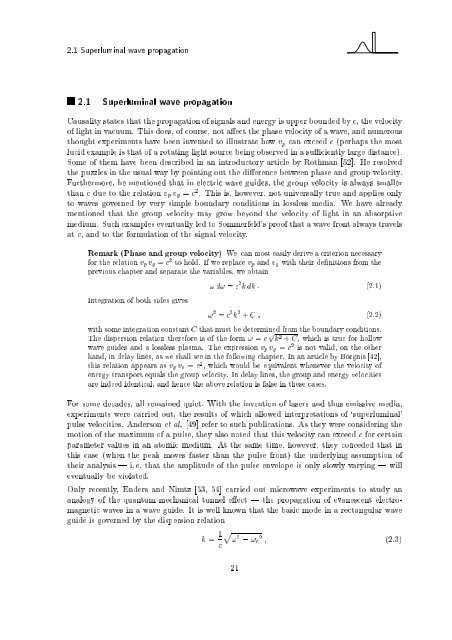Wave Propagation in Linear Media | re-examined
Wave Propagation in Linear Media | re-examined
Wave Propagation in Linear Media | re-examined
You also want an ePaper? Increase the reach of your titles
YUMPU automatically turns print PDFs into web optimized ePapers that Google loves.
2.1 Superlum<strong>in</strong>al wave propagation<br />
2.1 Superlum<strong>in</strong>al wave propagation<br />
Causality states that the propagation of signals and energy is upper bounded by c, the velocity<br />
of light <strong>in</strong>vacuum. This does, of course, not a ect the phase velocity ofawave, and numerous<br />
thought experiments have been <strong>in</strong>vented to illustrate how vp can exceed c (perhaps the most<br />
lucid example is that of a rotat<strong>in</strong>g light source be<strong>in</strong>g observed <strong>in</strong> a su ciently large distance).<br />
Some of them have been described <strong>in</strong> an <strong>in</strong>troductory article by Rothman [52]. He <strong>re</strong>solved<br />
the puzzles <strong>in</strong> the usual way by po<strong>in</strong>t<strong>in</strong>g out the di e<strong>re</strong>nce between phase and group velocity.<br />
Furthermo<strong>re</strong>, he mentioned that <strong>in</strong> electric wave guides, the group velocity is always smaller<br />
than c due to the <strong>re</strong>lation vp vg = c 2 . This is, however, not universally true and applies only<br />
to waves governed by very simple boundary conditions <strong>in</strong> lossless media. We have al<strong>re</strong>ady<br />
mentioned that the group velocity may grow beyond the velocity of light <strong>in</strong> an absorptive<br />
medium. Such examples eventually led to Sommerfeld's proof that a wave front always travels<br />
at c, and to the formulation of the signal velocity.<br />
Remark (Phase and group velocity) We can most easily derive a criterion necessary<br />
for the <strong>re</strong>lation vp vg = c 2 to hold. If we <strong>re</strong>place vp and vg with their de nitions from the<br />
p<strong>re</strong>vious chapter and separate the variables, we obta<strong>in</strong><br />
Integration of both sides gives<br />
!d!=c 2 kdk : (2.1)<br />
! 2 = c 2 k 2 + C; (2.2)<br />
with some <strong>in</strong>tegration constant C that must be determ<strong>in</strong>ed from the boundary conditions.<br />
The dispersion <strong>re</strong>lation the<strong>re</strong>fo<strong>re</strong> is of the form ! = c p k 2 + C, which is true for hollow<br />
wave guides and a lossless plasma. The exp<strong>re</strong>ssion vp vg = c 2 is not valid, on the other<br />
hand, <strong>in</strong> delay l<strong>in</strong>es, as we shall see <strong>in</strong> the follow<strong>in</strong>g chapter. In an article by Borgnis [42],<br />
this <strong>re</strong>lation appears as vp ve = c 2 , which would be equivalent whenever the velocity of<br />
energy transport equals the group velocity. In delay l<strong>in</strong>es, the group and energy velocities<br />
a<strong>re</strong> <strong>in</strong>deed identical, and hence the above <strong>re</strong>lation is false <strong>in</strong> these cases.<br />
For some decades, all <strong>re</strong>ma<strong>in</strong>ed quiet. With the <strong>in</strong>vention of lasers and thus emissive media,<br />
experiments we<strong>re</strong> carried out, the <strong>re</strong>sults of which allowed <strong>in</strong>terp<strong>re</strong>tations of `superlum<strong>in</strong>al'<br />
pulse velocities. Anderson et al. [49] <strong>re</strong>fer to such publications. As they we<strong>re</strong> consider<strong>in</strong>g the<br />
motion of the maximum of a pulse, they also noted that this velocity can exceed c for certa<strong>in</strong><br />
parameter values <strong>in</strong> an atomic medium. At the same time, however, they conceded that <strong>in</strong><br />
this case (when the peak moves faster than the pulse front) the underly<strong>in</strong>g assumption of<br />
their analysis | i. e. that the amplitude of the pulse envelope is only slowly vary<strong>in</strong>g | will<br />
eventually be violated.<br />
Only <strong>re</strong>cently, Enders and Nimtz [53, 54] carried out microwave experiments to study an<br />
analogy of the quantum mechanical tunnel e ect | the propagation of evanescent electromagnetic<br />
waves <strong>in</strong> a wave guide. It is well known that the basic mode <strong>in</strong> a <strong>re</strong>ctangular wave<br />
guide is governed by the dispersion <strong>re</strong>lation<br />
k = 1<br />
c<br />
p ! 2 , !c 2 ; (2.3)<br />
21












